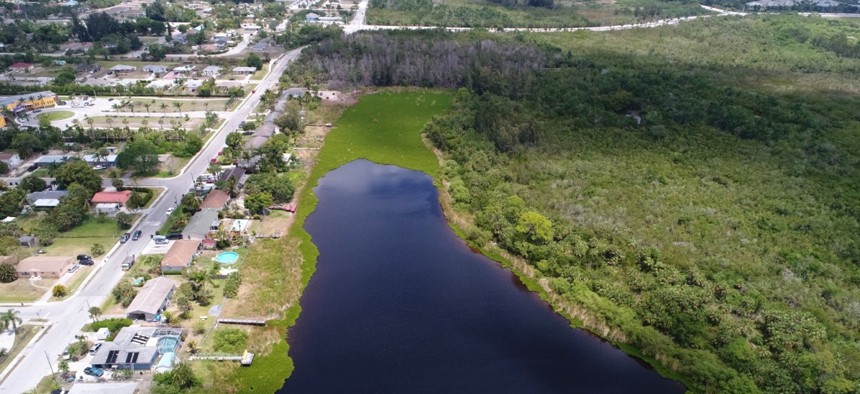This Florida County Will Use Drones for Mosquito Control

Lee County, Florida Photo courtesy of Lee County, Florida
Lee County is one of 10 government entities participating in a federal drone pilot program, but will be the only one to deploy the technology for pest control.
The buzz of mosquitoes in southwestern Florida has been joined by the whirring of aerial drones, which will now be deployed to help fight the biting pests as part of a Federal Aviation Administration pilot program announced earlier this month.
The Lee County Mosquito Control District is one of 10 state, local and tribal government bodies selected for the FAA’s Unmanned Aircraft System (UAS) Integration Pilot Program. Program participants will be able to operate drones under more relaxed standards than they can under current laws, which prohibit operators from flying over groups of people, at night or out of line of sight. In exchange, participants will gather data and feedback for the FAA that could be used to determine changes to future regulations for commercial and government drone use.
“Data gathered from these pilot projects will form the basis of a new regulatory framework to safely integrate drones into our national airspace,” U.S. Transportation Secretary Elaine Chao said in a statement.
Officials in Lee County applied for the program hoping to have the chance to weigh in on future regulations while also enhancing their current mosquito control program. The county already uses manned aircraft—helicopters and fixed-wing airplanes—to monitor hot-bed areas and spray pesticides to kill both adult mosquitoes and larvae. Last year officials expanded those efforts by partnering with the nearby Lee County Hyacinth Control District to pilot drones to help spot mosquito breeding grounds.
“Their responsibility is to make sure that waterways are cleaned up. It’s a big boating community down here,” Eric Jackson, spokesman for the Lee County Mosquito Control District, told Route Fifty in an interview. “Rivers will clog up sometimes with vegetation, and that kind of goes hand-in-hand with mosquito control, because as those areas start to fill up at the edges they can be prime habitats for mosquitoes.”
Mosquitoes lay their eggs in standing water, and when vegetation grows too thick it prevents fish from swimming in to feed on the larvae, Jackson said.
“So we use drones with the Hyacinth Control District to go out and monitor that vegetation,” he said.
Under the pilot program, the district could potentially use drones to search for larvae and pooling water in remote areas that can be difficult for inspectors to reach on foot.
“Our inspectors are out in the elements, in the 95-degree heat in the middle of the summer when it’s muggy and buggy,” Jackson said. “Climbing through vegetation can be challenging. Potentially, we could have a small drone lift off, and if we could operate it out of line of sight, we could scope things out from above and see where that water is pooling up.”
Down the road, department officials could use a larger, 1,500-pound drone to expand surveillance and pest treatment options, although the timeline is uncertain. The pilot program allows for relaxed operation of drones but does not supply funding to purchase new equipment. Final decisions about how to move forward will be made by the control district's commissioners.
“That’s going to be the big thing the commissioners will look at. If we’re going to pursue getting larger dones, where are we going to get the funding for that?” Jackson said. “It’s not like in two weeks we’ll get a 1,500-pound drone and have it in the air. There’s no way we can do that. It’ll most likely be baby steps. First we’ll start operating out of the line of sight, and then eventually, if it’s feasible, we might go the larger route.”
Commissioners will meet June 21 to go over the paperwork and formally approve the memorandum of agreement between the district and the FAA. At some point, an FAA representative will be assigned to the district to answer questions and help implement new policies. Every action undertaken during the pilot program will require FAA approval, which makes sense, Jackson said, as the ultimate goal is to help dictate future policy for drone usage.
“One of the big things that I really want to stress is that for us, it’s not just being able to operate a drone, it also has a lot to do with having a seat at the table to help set these regulations and have input on future ones,” Jackson said. “The big reason is safety, and that’s because we’ve got our pilots in the air all the time in manned aircraft.”
In Florida, where temperatures stay balmy all year, mosquitoes are a constant problem. They’re a nuisance, but also a potential economic issue as well as a public health risk. During peak season, which begins in mid-May, pilots are in the air almost every day, administering treatment and scouting for new hot spots.
“Starting in mid-May we get our first set of high tides that come in and flood the salt marsh and kick off the hatching, and on top of that we’re entering our rainy season,” he said. “As our airspace becomes more crowded with more of these drones, both commercial and private users, that can be a hazard to our pilots. We want to make sure these rules are developed thoughtfully and with manned aircraft in mind.”
Kate Elizabeth Queram is a Staff Correspondent for Government Executive’s Route Fifty and is based in Washington, D.C.
NEXT STORY: Poor People’s Campaign Protesters Land in Jail in State Capitals Across the Nation





